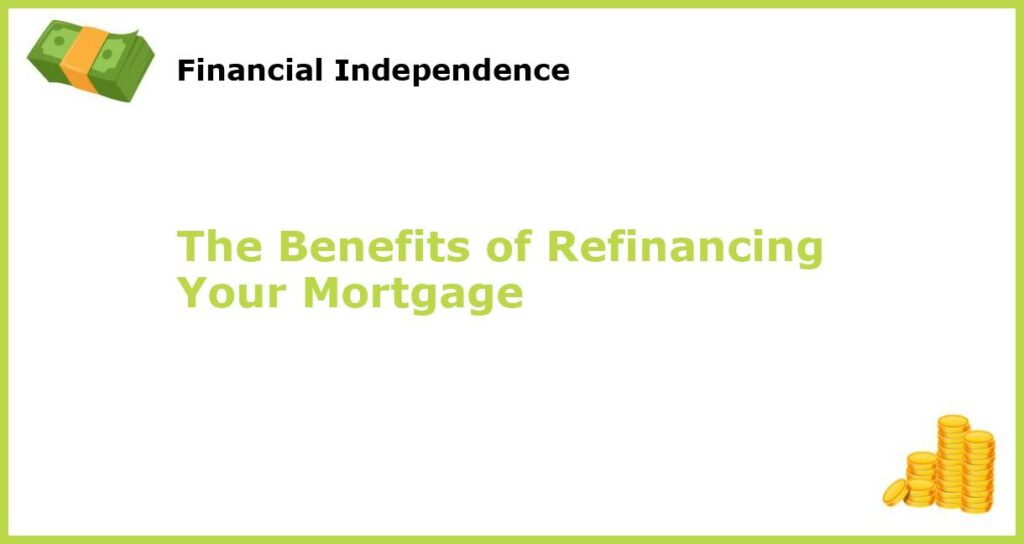Are you a homeowner, planning to save a significant amount of money on your mortgage payments? If yes, refinancing your mortgage is a viable option. Refinancing a mortgage means taking out a new mortgage to replace an existing one. A mortgage is refinanced for various reasons, primarily to lower interest rates, obtain a shorter loan term, avoid foreclosure, and borrow against your equity in your home. Let’s explore the benefits of refinancing your mortgage.
1. Lower Interest Rates

Lowering the interest rate on your mortgage is one of the top benefits of refinancing. Reducing the rate by even one percent can save you thousands of dollars over the life of the loan. This reduction can mean a lower monthly payment, allowing you to have more disposable income to invest or save for other projects. You must be aware that a lower interest rate does not always equal savings. Refinancing also comes with fees that can offset your savings. Be sure that the savings you’d gain in the long run more than make up for the refinancing costs.
2. Shorter Loan Terms

Shortening your loan term means paying off your mortgage debt in less time – usually 15 or 20 years instead of 30. Although your monthly payments may increase, you are saving a lot of money because of the reduced interest you’ll pay over the life of the loan. You’ll build equity in your home faster, and your interest rate will be lower. Also, with a shorter loan, you will have less financial stress on your shoulders because the mortgage will be paid off sooner.
3. Cash-Out Refinancing

Cash-out refinancing is taking out a new mortgage with a higher balance than your current one and pocketing the difference. The excess cash can be used for home improvements, paying off credit card debts, or any other personal use you may have. Tapping into your home equity through cash-out refinancing can be beneficial if you have high-interest short-term debt or an emergency expense that you need to pay off. The interest rate may be higher than a traditional refinance loan, so make sure you weigh the pros and cons before you take this step.
4. Switching from Adjustable to Fixed Rates

Adjustable-rate mortgages are subject to fluctuations in interest rates, making your monthly payments unpredictable. If you have an adjustable-rate mortgage and are comfortable with market rates, refinancing into a fixed-rate one may be a better option for you. You will have predictable monthly payments with a fixed-rate mortgage, providing stability and security. Even if the rate goes up in the future, your interest rate and payments will not increase, which is highly advantageous in uncertain economic times.
5. Eliminating PMI

If you have paid off at least 20 percent of your home’s appraised value, you can refinance your loan to eliminate private mortgage insurance (PMI). PMI is a type of protection for mortgage lenders in case a borrower defaults on their loan. By refinancing to eliminate PMI, you save hundreds of dollars every month. It is advisable to check with the lender whether the savings you’ll make will offset the refinancing costs before you refinance.
6. Consolidating Your Debt
If you have high-interest debts, such as credit card debt or car loans, you can consolidate them with your mortgages. This way, you lower your interest rate and monthly payments, making it easier to pay your bills. Rolling your unsecured debt into a secured loan with your house as collateral can be risky because if you can’t keep up with the payments, you could end up losing your home. However, if you can afford the repayment schedule, then a debt consolidation mortgage may be an excellent choice for you.
7. Improving Your Credit Score
Every time you make a payment on your mortgage, you’re building credit. Refinancing your mortgage at a lower interest rate can also help raise your credit score. Paying your bills on time and avoiding late payments demonstrate financial responsibility and improves your creditworthiness. A higher credit score can qualify you for future mortgages and loans, so make sure that your payment history is flawless before you take up a refinance loan
8. Changing Loan Servicers
If you are unhappy with your current loan servicer, you may be able to refinance your mortgage to switch to a loan servicer that meets your needs. You can choose a lender that has better customer service, more flexible payment options, or fewer fees than your current one. You have to be careful about the costs of refinancing and weigh up whether it’s worth it.
9. Increasing Your Home Equity
By refinancing your mortgage, you could be increasing your home equity. Home equity is the difference between the amount you owe on your mortgage and the market value of your home. Building home equity increases your borrowing power, and you can use it for other projects, such as home improvements or your child’s college education. An increased home equity value on your property can also result in cost savings on private mortgage insurance.
10. Avoiding Foreclosure
Refinancing can be a useful tool to avoid foreclosure if you’ve missed payments on your current mortgage or are struggling to make ends meet. Refinancing can help lower your monthly payment and help you restructure your debt. By refinancing, the lender works out a payment plan that fits your budget, with more manageable payments and higher payment terms that ensure you keep your property. It is vital to prioritize your finances to ensure that mortgage payment remains a priority, and refinancing is just a tool to help you meet those obligations.







